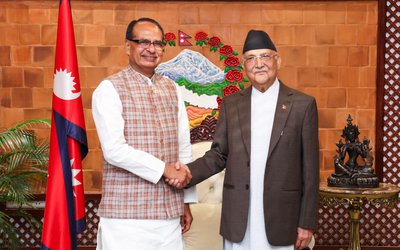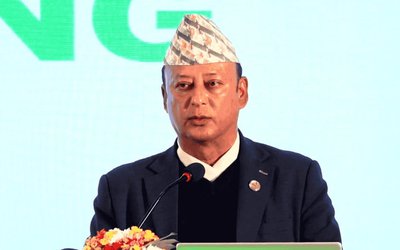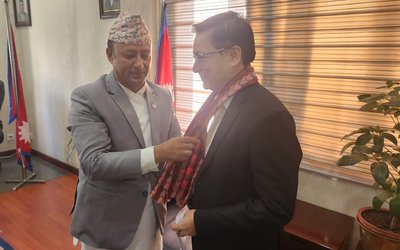More on National



Mani Kumar Katuwal, 50, a farmer of Jhulke Village Development Committee of Udayapur District, 600 kilometers east of the capital, saw his annual family income rise by five times after the construction of an all-weather road linking the village with the highway. Katuwal now sells his agriculture produce and milk products to urban areas.
“Every day, the milk tankers come to collect the milk and the traders come to us to buy our agriculture products, including vegetables. I am getting much higher prices for my products now than I did five years ago,” said Katuwal.
With road connection with the rest of the country, Katuwal’s income jumped to Rs. 15,000 or about US $150 a month.
“Now, I can go to Kathmandu or any other city by bus and return the next day.”
Katuwal is not alone making higher income after the road link opened. Most residents of Jhulke and the surrounding area have several reasons to rejoice. Farmers like Katuwal, who used to grow subsistence products like rice, wheat and mustard, are now growing vegetables to supply to urban centers.
The story does not end here. Hansa Chaudhari, 28, a primary school teacher of Bholtar, for example, holds the view that the number of school dropouts has declined due to the access to the road. "Two years ago, out of 60 students enrolled in Bhimsen Adarsha Nimna Madhyamik Vidyalaya, 40 dropped out the final exam. This year, out of 70 students enrolled, only 20 did not appear the final exam," said Chaudhari, a primary teacher. "We are also proud to say that we have contributed our land voluntarily to construct the road. This road is our lifeline now," said Chaudhari.
He said people were also developing the habit of visiting hospitals and health posts when needed.
There are 226,309 households with 1332602 people in the 248 VDCs with 1326 settlements under the zone of influence of the rural road projects. The RAIDP has already constructed more than 907 kilometers of roads. Of the total roads, 21, that is, nearly 62 percent roads, lie in Terai districts, and 13 roads (38 percent) in the hill districts. Of the total length of the roads, 520 km (nearly 58 percent) lies in Terai districts and 397 km (nearly 42 percent) in the hill.
Pralad Burma, a resident of Hardi village of Rupendehi district, in the bordering town of southern terai, 400 kilometer west of capital Kathmandu, too has seen similar transformation in the lives of people after the construction of roads. "The road helps us to ferry agriculture products, including vegetables, to the market in a short period of time," said Burma. "As we can sell fresh vegetables, our income has gone up. I am sending my children to school and I also have some additional money."
One of the beauties of the RAIDP's road projects is that the road is built up with the voluntary contribution of the land by the people. The road is constructed with the demand of people rather than being imposed from the center. The construction of rural roads helps increase productivity and mobility of the people. The utilization of improved rural transport infrastructure and service has contributed to reduce the level of poverty.
Rural Access and Decentralization Project has been implemented with the financial assistance of the World Bank since 2005. One of the aims of the project is to improve the existing rural roads, construct trail bridges and support for improvement of livelihood to eradicate poverty and good governance and accountability in the rural areas.
RAIDP program is designed to support efforts at poverty reduction in rural areas by promoting economic development and providing access to basic services that can increase the quality of life of the poor.
"RAIDP is one of the best rural road upgrading and construction projects of DoLIDAR with the financial assistance of the World Bank operating in 30 districts of Nepal. The project, along with existing road upgrading and construction is very much concerned with social and environmental issues equally," said Bhupendra Bahadur Basnet, director general of Department of Local Infrastructure Development and Agricultural Roads (DOLiDAR). “Moreover, the project has applied Good Governance and Accountability Action Plan (GAAP) which ensures responsible governance and cost effectiveness in each components of the project."
Increased Mobility
Thanks to the construction of roads, between 2006/07 and 2011, the number of all types of vehicles has increased. The overall growth of motorized vehicles is 37 percent. Similarly, 33 percent increment is seen of non-motorized vehicles during the same period. Increased rate of vehicles varies by districts. Among the vehicles jeep/ car/taxi increased by 52 percent followed by truck 44 percent, motorcycle 42 percent, and bus 35 percent. The travel time has come down 20-50 percent in the period of five years.
There are altogether 34 rural roads in original 20 districts of the RAIDP. Of the total roads, 12 are in Terai districts and the remaining are in the hill districts. Eight terai districts have two road projects. According to RAIDP, the project districts can be grouped into four clusters. Cluster I includes Kailali, Bardiya and Salyan and cluster two includes Kapilvastu, Rupandehi, Nawalparasi and Palpa. Similarly, cluster III includes Rasuwa, Kaski, Syangja, Dhading, Nuwakot and Makwanpur and cluster four includes Rautahat, Sarlahi, Mahottari, Dhanusha, Siraha and Udayapur.
Within a span of a decade, more than 907 kilometers of road have already been constructed under RAIDP road project.


